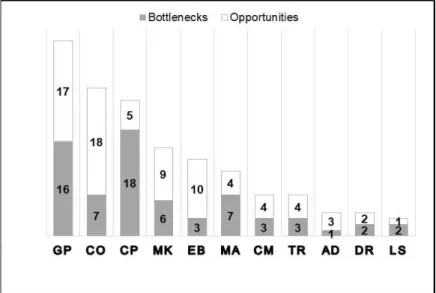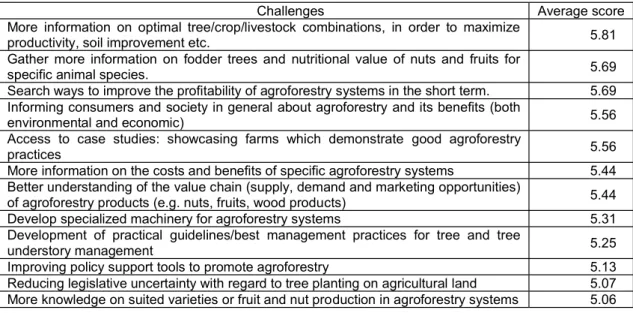AGROFORESTRY SYSTEMS AND INNOVATION IN
EXTRA-VIRGIN OLIVE OIL CHAIN IN CENTRAL ITALY
Pisanelli A1*, Consalvo C1, Martini E2, Lauteri M1, Camilli F3, Paris P1
(1) Istituto di Biologia Agro-Ambientale e Forestale, Consiglio Nazionale delle Ricerche, Porano (TR), Italy (2) Alta Scuola, Associazione Culturale e Scientifica, Orvieto (TR), Italy (3) Istituto di Biometeorologia, Consiglio Nazionale delle
Ricerche, Firenze, Italy
*Corresponding author: andrea.pisanelli@ibaf.cnr.it
Abstract
Although agroforestry systems are being acknowledged by relevant international policies, their adoption at EU farm levels is still hampered mainly due to lack of knowledge and expertise. In order to increase knowledge and awareness among stakeholders about agroforestry systems, the Agroforestry Innovation Network project (AFINET), funded within the EU H2020 research and innovation programme, has created Regional Agroforestry Innovation Networks (RAINs) in 9 EU countries focusing on different agroforestry practices.
This paper reports the activities carried out in the first RAIN meeting organized in Italy where AFINET project is focused on the multipurpose olive tree systems in the territory around Orvieto Municipality, Umbria Region, Central Italy. Stakeholders participating at the meeting perceived that the most relevant opportunities are related to the adoption of good practices, the implementation of cooperation among stakeholders, the enhancement of EU policies, the improvement of marketing of the extra-virgin olive oil.
Keywords: olive oil value chain; stakeholder knowledge; participative approach; innovation
Introduction
Global and European policies acknowledge the role that agroforestry can play to promote multifunctional agriculture providing products and delivering additional, highly important, ecosystem services. Nevertheless, it is also recognised that several constraints such as the lack of knowledge and expertise of farmers, land users and policy makers concerning agroforestry systems establishment and management hamper the adoption of agroforestry systems (Camilli et al. 2017).
In order to fill this gap, the European research project AFINET, Agroforestry Innovation Networks (http://www.eurafagroforestry.eu/afinet),
2017-H2020 research and innovation programme. AFINET acts at EU level in order to direct research results into practice and promote innovative ideas to face challenges and solve practitioners' problems. To achieve such a result, AFINET proposes an innovative methodology based on the creation of a European Interregional Network, linking different Regional Agroforestry Innovation Networks (RAINs). RAINs are working groups created in nine strategic European regions (Spain, UK, Belgium, Portugal, Italy, Hungary, Poland, France and Finland), interconnected and managed by the figures of the Innovation Brokers. RAINs represent different climatic, geographical, social and cultural conditions and enclose a balanced representation of the key actors with complementary types of expertise (farmers, policy makers, advisory services, extension services, etc.). Through AFINET, each project partner will organize six RAIN meetings throughout three years of activities.
The Italian RAIN is focused on multipurpose olive tree systems in the territory around Orvieto Municipality, Umbria Region, Central Italy. Umbria can be considered one of the most interesting regions because of the high quality production of both olive and extra-virgin oil and the linkage of oil production with local culture and environment. The area around Orvieto
Municipality is rich in olive orchards representing one of the most common land use practice (Martini 2010). Olive trees are still managed traditionally, often in marginal sites, with minimal mechanization and relatively low external inputs such as chemical treatments in comparison to other crops. The presence of permanent crops (olive trees) guarantees a partially tree cover reducing hydrogeological risk. Soil management usually keeps natural grassing reducing soil carbon emission and increasing soil fertility (Bateni 2017). Intercropping with cereals and/or fodder legumes and livestock can also be practiced in olive orchards, increasing the complexity of the olive tree multifunctional system. Moreover, olive orchards can be managed as agroforestry systems since they can be intercropped with arable crops (cereals, legumes) and/or combined with livestock (sheep, poultry).
The RAIN network includes the whole extra-virgin olive oil chain, from olives production on farm, to the olive processing, the olive oil and oil residues production, at the mill. The RAIN is expected to improve the management of olive orchards, promoting the adoption of agroforestry solutions and practices.
This paper reports the results obtained during the first RAIN meeting participated by the stakeholders of the local olive oil sector and the results from the online questionnaire sent to stakeholders to elicit the main agroforestry challenges to face in order to improve the local olive oil value chain.
Materials and methods
A description of the olive oil value chain in Umbria region was carried out consulting available bibliography. A network of local stakeholders including farmers, consultants, oil mill managers, researchers, policy makers and citizens was invited to be part of the Italian RAIN. The first RAIN meeting was organised the 15th September 2017 at the Orvieto Municipality, Umbria region. During the meeting, AFINET project and its objectives were presented together with the RAIN approach and methodology. A participative exercise was then implemented involving the participants. Stakeholders were invited to form three groups and join three tables of discussion in order to identify bottlenecks, knowledge gaps and challenges affecting the local olive oil supply chain. Each table had a panel indicating a specific issue related to the olive oil chain: climate and environment, socio-economy and policy. Each group of participants moved from a table to another in order to take part to the discussion of all the three issues. A facilitator at each table introduced the participative exercise and invited the stakeholders to discuss the issue reported on the panel. Then, each stakeholder was asked to attach on the panel three post-it with the main constraints and three post-it with the main opportunities related to the table issue. After the first RAIN meeting, an online questionnaire was submitted to the stakeholders who were asked to score (from 1, less important; to 6, very important) the agroforestry challenges to be implemented in order to improve the local olive oil value chain.
Results
The regional olive oil chain, involves about 30,000 farms growing olive trees in about 27,000 ha, and 270 oil mills; in 2014 the olive oil production was estimated to be about 3,152 tons (with a reduction of about 45% compared to 2013). In Umbria Olive trees are cultivated in the whole region and 5 Protected Designations of Origin (DOP) are represented: Colli Assisi Spoleto, Colli Martani, Colli Amerini, Colli del Trasimeno and Colli Orvietani. The main strength points of olive oil chain in Umbria are: i) high landscape value of olive orchards; ii) high quality level of the olive
According to the results of the participative exercise, stakeholders perceive that most of the bottlenecks and opportunities are related to good practices and innovation, cooperation among stakeholders, European policies, marketing of the extra-virgin olive oil, environment and climate. In Figure 1 bottlenecks and opportunities are reported separately in each category. It is interesting to see that, cooperation, marketing and environment are perceived more as opportunities than bottlenecks. On the contrary policy issues are perceived more as negative constraints than an opportunity. Good practices seem to be perceived both as opportunity and bottleneck probably because farmers recognize the potential benefits of agroforestry but they also perceive their management complexity.
Figure 1: Frequency of bottlenecks and opportunities within each category as perceived by the stakeholders. GP: good practice; CO: cooperation; CP: community policy; MK: marketing; EB: environment; MA: management; CM: communication; TR: training; AD: abandonment; DR: drought; LS: landscape.
Sixteen stakeholders responded to the online survey. All the agroforestry challenges were scored higher than 5.0 (Table 1). Most of the challenges should be addressed to improve the management of agroforestry systems, identifying best management practices to optimize production and environmental benefits and increase the knowledge about tree, crops and animal combination. The need to implement demonstrative fields, to educate consumers and land users about the benefits of agroforestry emerged also as key innovations. Moreover, the value chain of agroforestry products needs to be improved, in particular for the aspects concerning the profitability of specific agroforestry systems. Finally, European policy should be improved in order to facilitat
Table 1: results of the online survey carried out to score the different challenges that should be implemented in order to contrast the bottlenecks of the olive oil value chain.
Challenges Average score
More information on optimal tree/crop/livestock combinations, in order to maximize
productivity, soil improvement etc. 5.81
Gather more information on fodder trees and nutritional value of nuts and fruits for
specific animal species. 5.69
Search ways to improve the profitability of agroforestry systems in the short term. 5.69
Informing consumers and society in general about agroforestry and its benefits (both
environmental and economic) 5.56
Access to case studies: showcasing farms which demonstrate good agroforestry
practices 5.56
More information on the costs and benefits of specific agroforestry systems 5.44
Better understanding of the value chain (supply, demand and marketing opportunities)
of agroforestry products (e.g. nuts, fruits, wood products) 5.44
Develop specialized machinery for agroforestry systems 5.31
Development of practical guidelines/best management practices for tree and tree
understory management 5.25
Improving policy support tools to promote agroforestry 5.13
Reducing legislative uncertainty with regard to tree planting on agricultural land 5.07
More knowledge on suited varieties or fruit and nut production in agroforestry systems 5.06
Conclusion
The main strengths of the olive oil production sector in the Orvieto area, as emerged from the RAIN meeting discussion are: high quality of the product (extra-virgin olive oil), the linkage with local cultural traditions; the effects of olive orchards on biodiversity preservation; their influence on landscape fragmentation resulting in a valuable mosaic of co-existing elements, such as hedgerows, woodlots, herbaceous crops; soil erosion control; the use of intercropping, understory grazing and grassing down; high professional competence of the stakeholders. On the other side, the weaknesses are: high production costs; management complexity; small farm size; climate changes affecting vulnerability to pests and diseases. Furthermore, in order to compensate the high cost of oil production the RAIN intends to identify innovative uses of the residues of olive trees cultivation and olives processing, thus making the extra-virgin olive oil production sustainable.
rder to contrast bottlenecks and exploit opportunities of the olive oil supply chain, the possible innovations that should be taken into account are:
i) To introduce best practices: testing and experimenting innovative agroforestry systems introducing different crop/animals species and varieties;
ii) To improve the management of the olive orchards: encouraging and increasing the organic production;
iii) Valorization of olive processing residues: identifying and testing innovative products (bio-materials, olive paste as example);
iv) To raise the awareness among consumers: educating people about the benefits of olive oil consumption, creating networks among stakeholders, improving marketing and commercialization.
References
Bateni C (2017) Soil carbon stock in olive groves agroforestry systems under different management and soil characteristics. Master in Environmental Management of Mountain Areas Thesis Faculty of Science, university of Bolzano.
Camilli F, Pisanelli A, Seddaiu G, Franca A, Bondesan V, Rosati A, Marcos Moreno G, Pantera A, Hermansen JE, BurgessPJ (2017) How local stakeholders perceive agroforestry systems: an Italian perspective. Agrofor Syst https://doi.org/10.1007/s10457-017-0127-0.
Martini E (2010)
Promotion). Fête 2° édition: Meknes (Maroc), 17-19 Juin 2010. KNOLEUM, paysages Interreg III B Knoleum concernant la filière olévicole.

